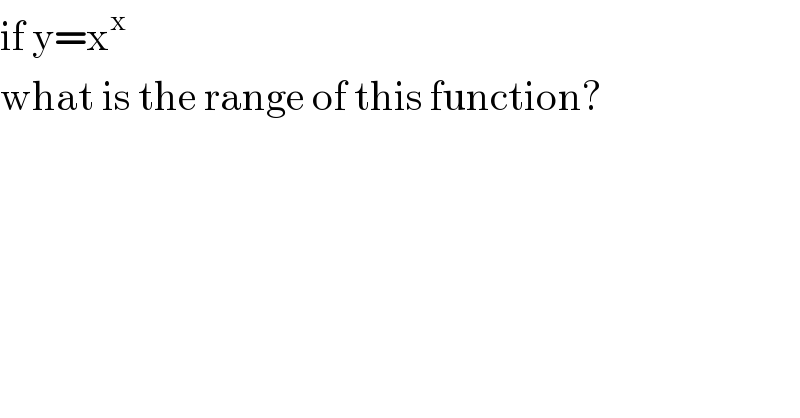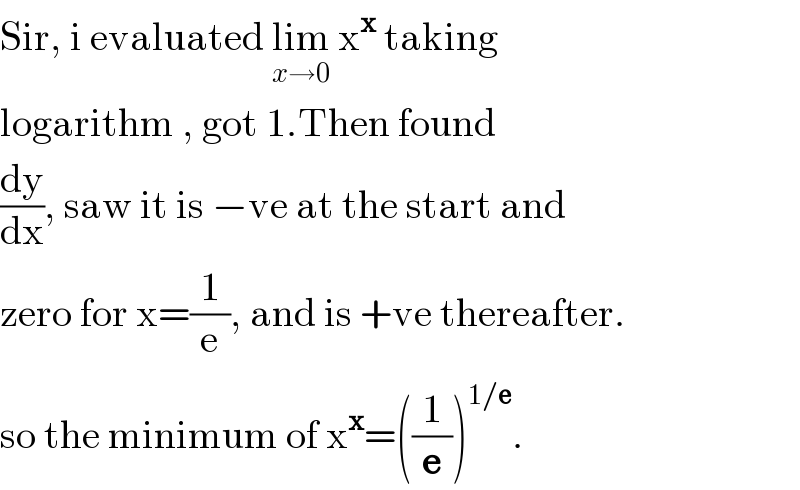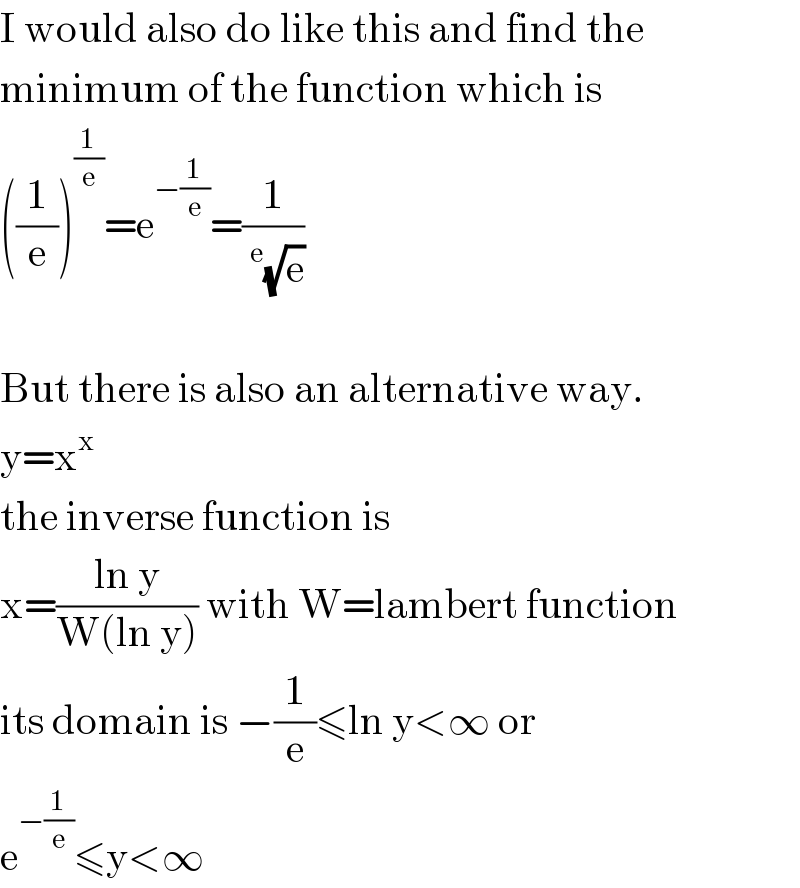
Question Number 17065 by mrW1 last updated on 30/Jun/17

$$\mathrm{if}\:\mathrm{y}=\mathrm{x}^{\mathrm{x}} \\ $$$$\mathrm{what}\:\mathrm{is}\:\mathrm{the}\:\mathrm{range}\:\mathrm{of}\:\mathrm{this}\:\mathrm{function}? \\ $$
Commented by ajfour last updated on 30/Jun/17

$$\mathrm{y}\in\left[\mathrm{e}^{−\mathrm{1}/\mathrm{e}} ,\infty\right). \\ $$
Commented by mrW1 last updated on 30/Jun/17

$$\mathrm{that}'\mathrm{s}\:\mathrm{right}. \\ $$
Commented by ajfour last updated on 30/Jun/17

$$\mathrm{Sir},\:\mathrm{i}\:\mathrm{evaluated}\:\underset{{x}\rightarrow\mathrm{0}} {\mathrm{lim}}\:\mathrm{x}^{\boldsymbol{\mathrm{x}}} \:\mathrm{taking} \\ $$$$\mathrm{logarithm}\:,\:\mathrm{got}\:\mathrm{1}.\mathrm{Then}\:\mathrm{found} \\ $$$$\frac{\mathrm{dy}}{\mathrm{dx}},\:\mathrm{saw}\:\mathrm{it}\:\mathrm{is}\:−\mathrm{ve}\:\mathrm{at}\:\mathrm{the}\:\mathrm{start}\:\mathrm{and} \\ $$$$\mathrm{zero}\:\mathrm{for}\:\mathrm{x}=\frac{\mathrm{1}}{\mathrm{e}},\:\mathrm{and}\:\mathrm{is}\:+\mathrm{ve}\:\mathrm{thereafter}. \\ $$$$\mathrm{so}\:\mathrm{the}\:\mathrm{minimum}\:\mathrm{of}\:\mathrm{x}^{\boldsymbol{\mathrm{x}}} =\left(\frac{\mathrm{1}}{\boldsymbol{\mathrm{e}}}\right)^{\mathrm{1}/\boldsymbol{\mathrm{e}}} . \\ $$
Commented by mrW1 last updated on 30/Jun/17

$$\mathrm{I}\:\mathrm{would}\:\mathrm{also}\:\mathrm{do}\:\mathrm{like}\:\mathrm{this}\:\mathrm{and}\:\mathrm{find}\:\mathrm{the} \\ $$$$\mathrm{minimum}\:\mathrm{of}\:\mathrm{the}\:\mathrm{function}\:\mathrm{which}\:\mathrm{is} \\ $$$$\left(\frac{\mathrm{1}}{\mathrm{e}}\right)^{\frac{\mathrm{1}}{\mathrm{e}}} =\mathrm{e}^{−\frac{\mathrm{1}}{\mathrm{e}}} =\frac{\mathrm{1}}{\:^{\mathrm{e}} \sqrt{\mathrm{e}}} \\ $$$$ \\ $$$$\mathrm{But}\:\mathrm{there}\:\mathrm{is}\:\mathrm{also}\:\mathrm{an}\:\mathrm{alternative}\:\mathrm{way}.\: \\ $$$$\mathrm{y}=\mathrm{x}^{\mathrm{x}} \\ $$$$\mathrm{the}\:\mathrm{inverse}\:\mathrm{function}\:\mathrm{is} \\ $$$$\mathrm{x}=\frac{\mathrm{ln}\:\mathrm{y}}{\mathrm{W}\left(\mathrm{ln}\:\mathrm{y}\right)}\:\mathrm{with}\:\mathrm{W}=\mathrm{lambert}\:\mathrm{function} \\ $$$$\mathrm{its}\:\mathrm{domain}\:\mathrm{is}\:−\frac{\mathrm{1}}{\mathrm{e}}\leqslant\mathrm{ln}\:\mathrm{y}<\infty\:\mathrm{or} \\ $$$$\mathrm{e}^{−\frac{\mathrm{1}}{\mathrm{e}}} \leqslant\mathrm{y}<\infty \\ $$
